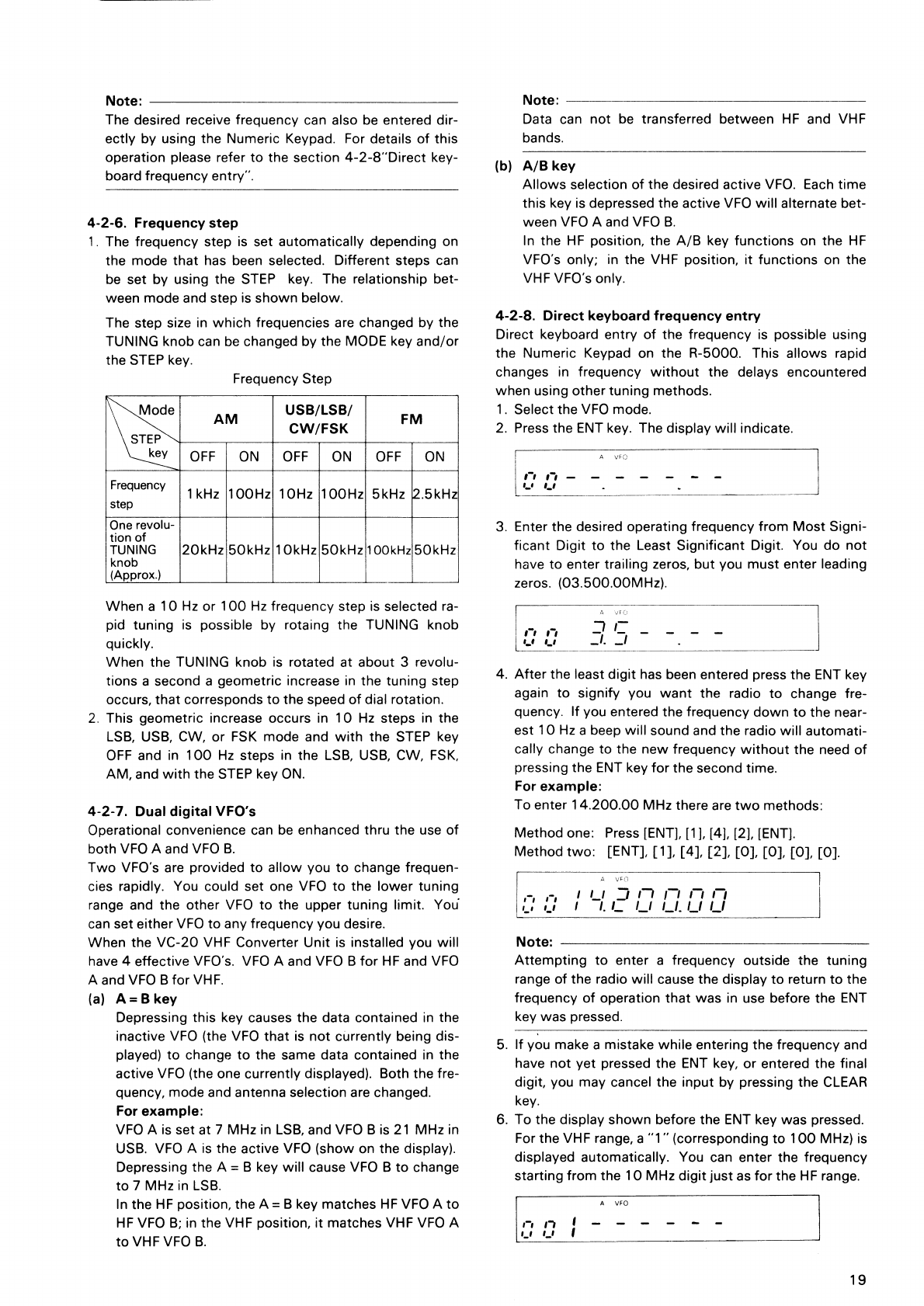
Note:
The desired receive frequency can also be entered dir-
ectly by using the Numeric Keypad. For details of this
operation please refer to the section 4-2-8"Direct key-
board frequency entry".
4-2-6. Frequency step
1.
The frequency step is set automatically depending on
the mode that has been selected. Different steps can
be set by using the STEP key. The relationship bet-
ween mode and step is shown below.
The step size in which frequencies are changed by the
TUNING knob can be changed by the MODE key and/or
the STEP key.
Frequency Step
When a 10 Hz or 100 Hz frequency step is selected ra-
pid tuning is possible by rotaing the TUNING knob
quickly.
When the TUNING knob is rotated at about 3 revolu-
tions a second a geometric increase in the tuning step
occurs, that corresponds to the speed of dial rotation.
2.
This geometric increase occurs in 10 Hz steps in the
LSB, USB, CW, or FSK mode and with the STEP key
OFF and in 100 Hz steps in the LSB, USB, CW, FSK,
AM, and with the STEP key ON.
4-2-7. Dual digital VFO's
Operational convenience can be enhanced thru the use of
both VFO A and VFO B.
Two VFO's are provided to allow you to change frequen-
cies rapidly. You could set one VFO to the lower tuning
range and the other VFO to the upper tuning limit. You'
can set either VFO to any frequency you desire.
When the VC-20 VHF Converter Unit is installed you will
have 4 effective VFO's. VFO A and VFO B for HF and VFO
A and VFO B for VHF.
(a) A = B key
Depressing this key causes the data contained in the
inactive VFO (the VFO that is not currently being dis-
played) to change to the same data contained in the
active VFO (the one currently displayed). Both the fre-
quency, mode and antenna selection are changed.
For example:
VFO A is set at 7 MHz in LSB, and VFO B is 21 MHz in
USB. VFO A is the active VFO (show on the display).
Depressing the A = B key will cause VFO B to change
to 7 MHz
in
LSB.
In the HF position, the A = B key matches HF VFO A to
HF VFO B; in the VHF position, it matches VHF VFO A
to VHF VFO B.
Note:
Data can not be transferred between HF and VHF
bands.
(b) A/B key
Allows selection of the desired active VFO. Each time
this key is depressed the active VFO will alternate bet-
ween VFO A and VFO B.
In the HF position, the A/B key functions on the HF
VFO's only; in the VHF position, it functions on the
VHF VFO's only.
4-2-8. Direct keyboard frequency entry
Direct keyboard entry of the frequency is possible using
the Numeric Keypad on the R-5000. This allows rapid
changes in frequency without the delays encountered
when using other tuning methods.
1.
Select the VFO mode.
2.
Press the ENT key. The display will indicate.
3.
Enter the desired operating frequency from Most Signi-
ficant Digit to the Least Significant Digit. You do not
have to enter trailing zeros, but you must enter leading
zeros. (03.500.00MHz).
4.
After the least digit has been entered press the ENT key
again to signify you want the radio to change fre-
quency. If you entered the frequency down to the near-
est 10 Hz a beep will sound and the radio will automati-
cally change to the new frequency without the need of
pressing the ENT key for the second time.
For example:
To enter 14.200.00 MHz there are two methods:
Method one: Press [ENT], [1], [4], [2], [ENT].
Method two: [ENT], [1], [4], [2], [0], [0], [0], [0].
Note:
Attempting to enter a frequency outside the tuning
range of the radio will cause the display to return to the
frequency of operation that was in use before the ENT
key was pressed.
5.
If you make a mistake while entering the frequency and
have not yet pressed the ENT key, or entered the final
digit, you may cancel the input by pressing the CLEAR
key.
6.
To the display shown before the ENT key was pressed.
For the VHF range, a "1" (corresponding to 100 MHz) is
displayed automatically. You can enter the frequency
starting from the 10 MHz digit just as for the HF range.
19


















